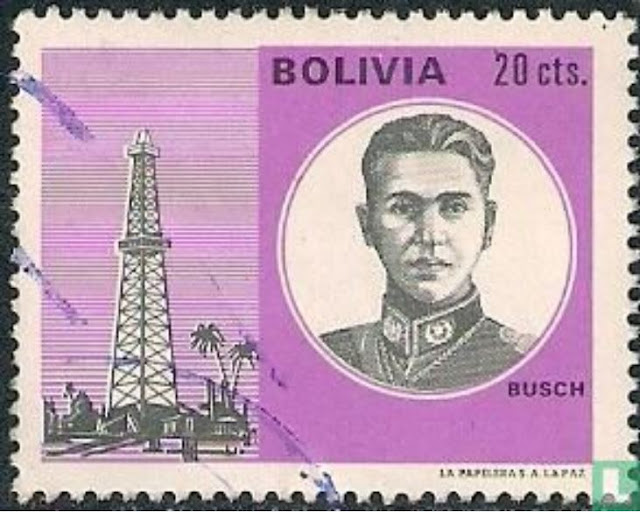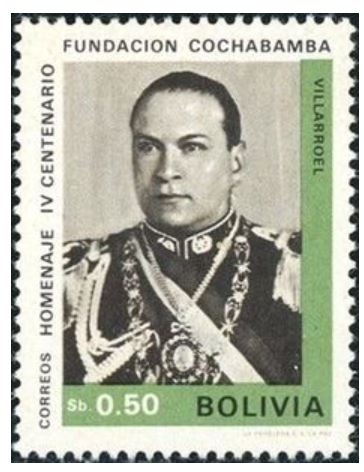 |
Gualberto Villarroel López (Source: Internet) |
The President of the country was hanged on a lamp post.
He died on 21 July 1946 at the age of 37 years only.
He was Gualberto Villarroel López (born on December 15, 1908), the 39th President of Bolivia.
There are several versions available about his death. It is said that he was found hiding inside a cupboard of Palacio Quemado, the Presidential Place of Bolivia, by the rioters who had stormed the palace, looking for him.
One story says that rioters heard some noise from the closed cupboard and when they opened it, the seriously injured Villarroel tumbled out. Another version goes that Villarroel himself opened the cupboard from inside and came out firing from his revolver. He was instantaneously gunned down by the rioters.
Going back to history, in 1936, army authority took over the government in Bolivia viz. Colonel David Toro (1936-37), followed by Major Busch (1937-39).
 |
| Major Busch (Source: Internet) |
The period was some sort of military socialism. Under the regime of Toro, the holdings of Standard Oil Company were confiscated and taken over by the government. Petroleum industry of Bolivia was nationalized through The Hydrocarbons Law No. 1689. Major Busch was featured in a postage stamp, where nearly half portion of the stamp was covered with the picture of an oil derrick. The petroleum industry of Bolivia had undergone a cycle of nationalization (1916 to 1920), de-nationalization (1920 to 1937) and again nationalization (1937). Much later, in 1956, American oil companies were invited back by the new Bolivian government. But that was a different story.
Villarroel was a military officer of Bolivian Army. With several twists and turns of the political and military maneuvers, he assumed power through a military coup against General Enrique Penaranda. He became the youngest president of Bolivia on 20 Dec 1943, at the age of 35 years only.
 |
| Peso (Source: Internet) |
He featured in currencies of Bolivia. While his picture was there in the front side of the bill of Pesos, the reverse side had petroleum industry. There were distillation column, storage tanks, horton spheres etc.
On 06 Nov 1968, two sets of commemorative stamps, each consisting of five postage stamps, featuring Villarroel, were issued to observe the 400th anniversary of Cochabamba.
 |
| Foundation of Cochabamba 1 |
Cochabamba, a Bolivian city which was once inhabited by the Incas.
 |
| Foundation of Cochabamba 2 |
In modern times, the foundation of the city was laid on 02 Aug'1571.
 |
| Foundation of Cochabamba 3 |
 |
| Foundation of Cochabamba 4 |
 |
| Foundation of Cochabamba 5 |
The silver mining had peaked there in seventeenth century and industry based prosperity declined as mining industry ended.
 |
| Foundation of Cochabamba 3 of set 2 (source: Internet) |
 |
| Foundation of Cochabamba balance 2 of set 2 (source: Internet) |
Villarroel, with the objective of eliminating social injustices meted out to indigenous agricultural and farm worker by the elite landlords, issued decrees. His decrees made the tyrannical treatment of oppressed indigenous workers by landowners illegal. In fact, it was the beginning of a new era of socioeconomic reform progress. This was a blow to the rich and powerful who have been exploiting the indigenous people since ages. The strong and power wielding elites were unhappy with him. His reform proposals included recognition of workers union, voluntary retirement with pension benefits etc.
 |
| Se-tenet stamps (source: Internet) |
His decree was featured in se-tenant stamps of Bolivia (Se-tenant stamps are a pair of stamps, joined together, having different designs) issued on 26 Jan 1996, many years later after his death. The theme was 'The 50th anniversary decree for abolition of enforced Amerindian labour'. One of the stamp depicted road and rail transportation, apartment blocks etc., depicting socioeconomic progress. The another stamp had the president Villarroel addressing congress and workers celebrating freedom in the foreground. Horton Spheres, which are used for storage gaseous petroleum products like LPG, cannot be ignored in both the stamps.
 |
| Issued 12.11.1975 (source: Internet) |
On one side, he was credited with issuing decrees for social reform, on the other hand he was responsible for brutal suppression of the opposition. A coup against him failed in 1944 and he eliminated opposition ruthlessly. Later in 1946, teachers of the country went on a strike. Gradually the strike turned violent and mob stormed the palace. He was killed by the rioters within the palace.
 |
| With surcharge (source: Internet) |
His tragedy didn't end even after his death. Rioters tossed his body out of the window of the palace on the street. The mad mob lynched his lifeless body, and his almost naked body was hanged on a nearby lamp post. After his demise, the opposition gained control which lasted till the Bolivian Revolution of 1952.
 |
| 1 of 11 |
On the first anniversary of the revolution of 09 Apr’1952, a set of identically designed eleven stamps of different colors and face values was issued on 01 Sept 1953.
 |
| 2 of 11 |
 |
| 3 of 11 |
Villarroel was featured along with other presidents.
 |
| 4 of 11 |
 |
| 5 of 11 |
Ángel Víctor Paz Estenssoro (October 2, 1907 – June 7, 2001).
 |
| 6 of 11 |
 |
| 7 of 11 |
And Hernán Siles Zuazo (21 March 1914 – 6 August 1996).
 |
| 8 of 11 |
 |
| 9 of 11 |
Estenssoro was four times President of Bolivia.
 |
| 10 of 11 |
 |
| 11 of 11 |
Zuazo was Vice President once and served as President twice.
 |
| President and Petroleum (source: Internet) |
*************
Webliography:
https://gualbertovillarroel.com/
https://www.britannica.com/place/Bolivia/Post-1952-regimes
https://en.wikipedia.org/wiki/Gualberto_Villarroel
https://www.lhistoria.com/bolivia/cochabamba
http://countrystudies.us/bolivia/60.htm
Disclaimer:
The information provided in the article is for general informational purposes only. All information is provided in good faith. This is only for sharing of knowledge of philately with philatelist fraternity of the world. No commercial or political angle, whatsoever, is involved. No intention to infringe any type of copyright. Under no circumstances I shall have any liability for reliance on any information provided in the story.
The story was published in the popular philately e-magazine Ananthapuri Stamp Bulletin Aug 2022 issue. Relevant pages are posted here.
 |
| Cover page |
 |
| Index |
 |
| Page 1 of 2 |
 |
| Page 2 of 2 |
 |
| Feedback |





Very interesting story of Bolivia. Shri Biswas has touched the nuances of Bolivian History with sensibility. I have just one point. The 400th year of the foundation of Cochabamba was to be observed in 1968, or in 1971 ? - T K Basu, Nagpur.
ReplyDelete